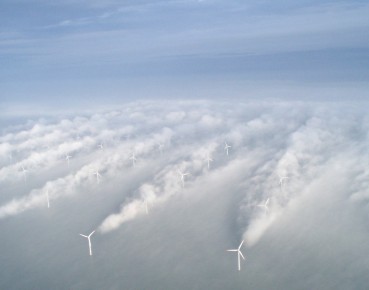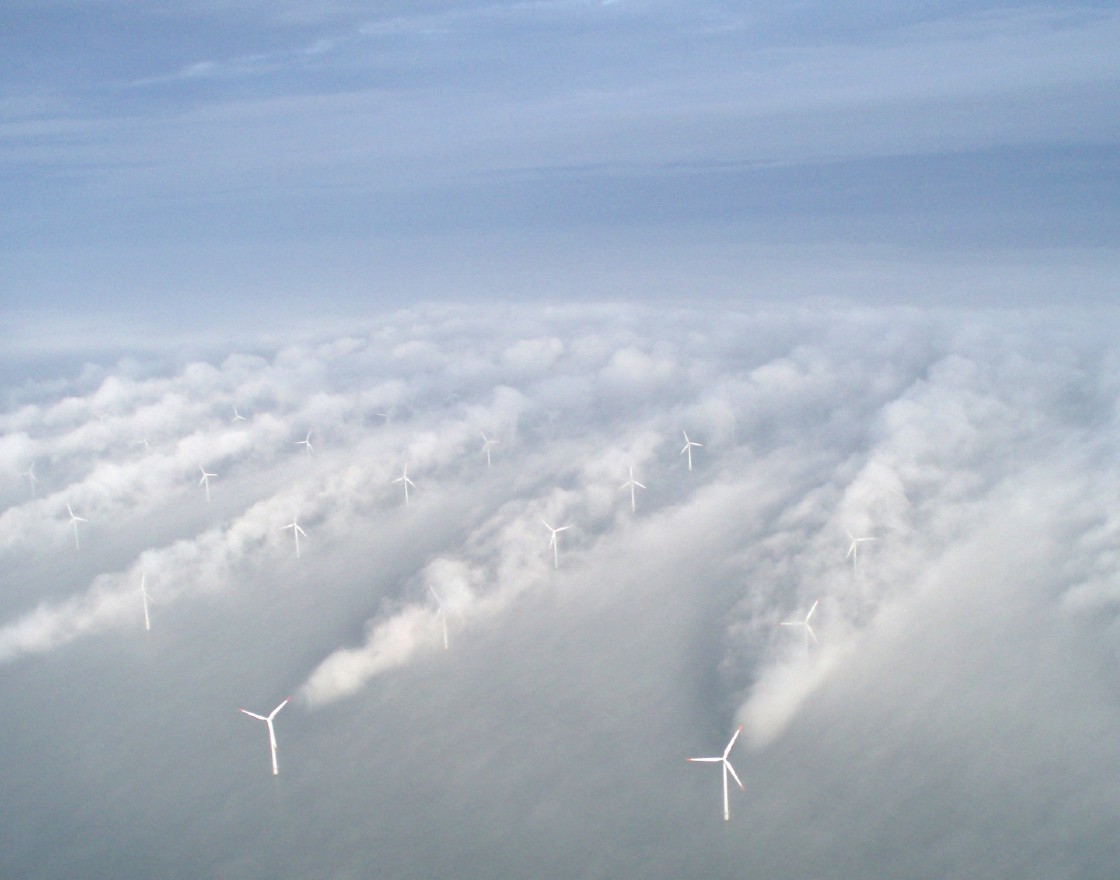
(Vattenfall, CC BY-ND)
„Offshore wind farms provide just 0.3 per cent of the global electricity production, but their potential is vast,” says Fatih Birol, the Executive Director of the Paris-based International Energy Agency (IEA).
Gigawatts of growth
Today electricity is produced in offshore wind farms by more than 5,500 offshore wind turbines in 17 countries around the world. According to data covering projects that are currently being implemented and those in the design phase, over the next five years approximately 150 new farms should be put into operation. More than 100 of these are expected to launch production by the end of 2021.
The IEA expects that over the next two decades the generation capacity of offshore wind farms in the world will have reached 342 GW, and if the objectives of the Paris climate agreement of 2015 are to be achieved, then it should reach 562 GW. The same forecast indicates that in the member states of the European Union these values should amount to 127 GW and 175 GW, respectively.
An even higher rate of growth in installed power generation capacity is expected in China, whose offshore wind energy sector is still in its infancy, at least compared with Europe, where the first wind farm was launched in 1991. Wind power generation capacity in China is projected to increase from the current level of 4 GW to 110 GW in 2040, and to 170 GW — if the climate objectives are to be reached.
According to the IEA, based on the investment plans already announced by the companies, as well as the political declarations, it can be estimated that the installed capacity of offshore wind farms will grow by 13 per cent per year over the next two decades, and the total capital expenditures incurred during this period will reach USD840bn. If these investments are accelerated in order to ensure that the global climate and sustainability goals are met, the total expenditures will increase to USD1.3 trillion. In the case of the European Union the latter scenario would mean total investment expenditures of USD500bn, that is 33 per cent higher than in the currently implemented scenario.
Europe is the global leader in the wind energy
Europe is the global leader in offshore wind energy, not only in terms of installed capacity, but also in terms of technology. By the end of 2018, offshore wind farms with the biggest generation capacity operated in the United Kingdom (8 GW) and in Germany (6.5 GW). European countries also had the world’s highest share of power produced by offshore wind farms in the overall electricity production. This share reached 15 per cent in Denmark, 8 per cent in the United Kingdom, and 5 per cent in Belgium.
There are two companies from Europe among the five largest producers of turbines used in offshore wind farms. The global leader is the Spanish-based company Siemens Gamesa (a 41 per cent share in the global market in 2018, and a 63 per cent share in the years 1995-2018), while the Danish company MHI Vestas ranks the second (a 30 per cent share in 2018 and a 18 per cent share in the years 1995-2018). The next three spots are occupied by Chinese manufacturers: Envision (15 per cent and 4 per cent), Goldwind (8 per cent and 3 per cent), and Yang Ming (2 per cent and 1 per cent).
Despite the fact that the costs decreased by 60 per cent over the past six years, investments in offshore wind farms are still relatively expensive. The cost of 1 megawatt of installed capacity is currently significantly higher than in the case of solar power plants as well as onshore wind farms. In 2018, these costs — also taking into account the expenditures on the connection of the wind farm to the mainland power grid — amounted to an average of more than USD4,300 per kW. According to the IEA, over the next 20 years these costs will have decreased by more than 55 per cent, with a 40 per cent decline possible by 2030.
It is assumed that the main driving force behind these price reductions will be the lower costs of turbines (which are expected to drop by 60 per cent). Meanwhile, the investment expenditures on the connection of the farms to the mainland power grid will remain unchanged at approximately USD1,000 per kW. The financing costs of such investments, which currently reach between 20 per cent and 30 per cent of the total value of the project, will be a very sensitive element. This item is directly dependent on the interest rate of the debt incurred for the purpose of financing the investments. The IEA expects that thanks to preferential loans granted by financial institutions such as the European Investment Bank (in mid-November 2019, the EIB adopted a new energy policy geared towards the financing of renewable energy sources), the financial costs will be reduced by up to 40 per cent over the forecast period.
A business field for the largest energy companies
The IEA emphasizes that the new offshore wind farm projects are implemented in Europe thanks to the larger size of the turbines, which have capacity factors of 40-50 per cent, permitting a better utilization of the wind. This value is up to two times higher than in the case of wind turbines installed on land, and three times higher than in the case of solar power plants.
Meanwhile, within the next decade, the cost of energy production at offshore wind farms in China could become competitive in relation to the costs of energy production at new coal-fired power plants and comparable with the costs of energy production at onshore wind farms and solar power plants.
The IEA notes that due to the high capital expenditures that must be incurred, offshore wind farms are primarily built by large energy companies, oil and gas companies, as well as wealthy financial investors. Today, the biggest players in the wind energy market include the Danish company Ørsted, the German company REW, the Chinese state-owned enterprise China Longyuan, the Swedish company Vattenfall, and the Australian private equity fund Macquarie Capital. According to data from Bloomberg New Energy Finance, at the end of 2018 these five entities accounted for 8.4 GW of installed power generation capacity, 4.8 GW of capacity under construction, and 13.1 GW in planned capacity.
The conservative expectations of Poland’s National Energy Policy
The draft National Energy Policy until 2040 identifies offshore wind farms as an important source of electricity in Poland. In the latest version of the draft policy (released in November 2019), it is even stated that “offshore wind farms will play a key role in achieving the adopted objectives in the area of electricity generation”, and that “it is anticipated that these sources will be responsible for the greatest amount of electricity produced from renewable energy sources by 2040”.
In the original version of the draft, published a year earlier, it was predicted that in 20 years the generation capacity of Polish offshore wind farms would reach 10.3 GW. In the current version the authors predict a future capacity of less than 8 GW.
In the draft policy it is assumed that the first offshore wind farm in Poland will be launched in 2025. Its capacity is expected to reach 750 MW. Meanwhile, offshore wind farms with a total capacity of 3.8 GW are expected to be in operation five years after that. The authors of the draft point out that “the launch of investments in these capacities is dependent on the completion of works aimed at strengthening the transmission network in the northern part of Poland, so that it is possible to transmit the energy generated at the offshore wind farms to the country’s interior”.
According to the draft policy, the construction costs of 1 kW of installed capacity will drop from EUR2,450 in 2020 to EUR2,250 in 2030, and to EUR2,075 by the end of the forecast period. The authors do not specify whether these costs include the investment expenditures associated with the connection to the national electricity network, or whether these are just the costs of the offshore wind farms alone.
The seven biggest offshore wind farm projects
In the opinion of experts in the field of renewable energy, the projections for the installed capacities that were included in the draft National Energy Policy until 2040 are relatively conservative. In their view, there is potential for the development of much greater generation capacities reaching up to 30 GW. Importantly, the forecast presented in the draft policy is only slightly higher than the total capacity of seven offshore wind farms whose development is the most advanced, and which have already signed connection agreements or received the terms and conditions for the connection to the national network. Their combined installed capacity amounts to almost 7.1 GW.
These seven farms include three projects pursued by Polenergia (a private energy company), two projects belonging to the PGE Group (the biggest Polish energy group), as well as individual projects conducted by PKN Orlen (the biggest Polish oil&gas company) and RWE Renewables (in late October 2019 the German company revealed that it purchased the Baltic II project previously developed by Baltic Trade & Invest).
Polenergia is potentially the biggest investor, planning the construction of offshore wind farms with a total capacity of 3 GW. Its projects are to be implemented in partnership with the company Equinor, which acquired 50 per cent of shares in each project. PGE is planning the development of installed capacities of 2.5 GW by 2030, and 1 GW to 2 GW in the following years. It plans to partner with the Danish company Ørsted, which is supposed to take over half of the shares in the special purpose vehicles Elektrownia Wiatrowa Baltica-2 (Baltica-3 Wind Power Plant) and Elektrownia Wiatrowa Baltica-3 (Baltica-3 Wind Power Plant). PKN Orlen hasn’t yet chosen a partner for its project with a planned capacity of 1.2 GW. According to media reports, the potential candidates include Ørsted and the Swedish company Vattenfall.
Apart from these four entities, interest in the construction of offshore wind farms has been expressed by three state-owned energy companies – Energa, Enea (planned capacity of approximately 700 MW in 2030) and Tauron, as well as the one of the wealthiest Polish entrepreneurs Michał Sołowow (who discussed the construction of a farm with a capacity of 800 MW). Besides the Baltic II project, RWE Renewables also purchased three other unnamed projects and is theoretically prepared to invest in the development of combined generation capacities of 1.5 GW.
Investors estimate that the supply of electricity from these projects could be launched in 2025 (Polenergia) and 2026 (PGE and PKN Orlen). Polenergia has stated that “the date of commencement of the construction works on the offshore wind farms depends on the entry into force of the relevant regulatory system”. The lacking legislation includes a special “offshore wind farms act”, as well as a local zoning and spatial development plan which is supposed to be announced in the form of a government regulation. During the 5th Energy Congress held in September 2019, Olivia Breese from the Danish company Ørsted assessed that if the law is enacted in 2020, then the first offshore wind farms will launch their operations in the years 2024-2025.
The expected volume of the investment expenditures was only disclosed by the PGE Group (USD7.2bn by 2030) and PKN Orlen (USD2.9-3.1bn). If we were to take these values as benchmarks, then the total costs of the seven most advanced projects could be estimated at USD18-23 billion.


